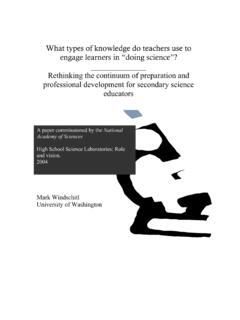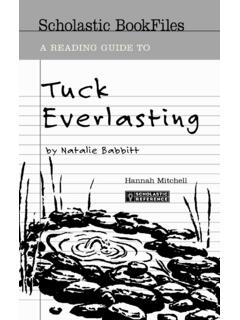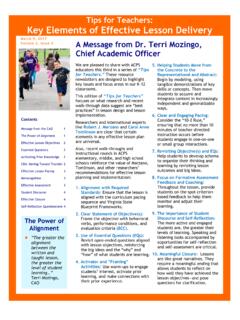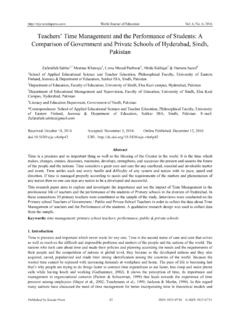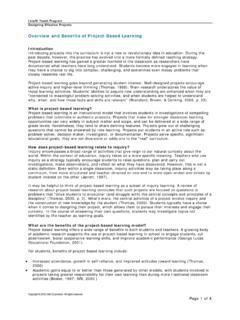Transcription of Teachers’ Beliefs in English Language Teaching and ...
1 English Language Teaching ; Vol. 10, No. 4; 2017 ISSN 1916-4742 E-ISSN 1916-4750 Published by Canadian Center of Science and Education 78 Teachers Beliefs in English Language Teaching and Learning: A Review of the Literature Abbas Pourhosein Gilakjani1 & Narjes Banou Sabouri2 1 Lahijan Branch, Islamic Azad University, Lahijan, Iran 2 Department of Linguistics, Payame Noor University, Tehran, Iran Correspondence: Abbas Pourhosein Gilakjani, Lahijan Branch, Islamic Azad University, Lahijan, Iran. Tel: 98-13-4263-2762. E-mail: Received: February 4, 2017 Accepted: March 6, 2017 Online Published: March 9, 2017 doi: URL: Abstract Beliefs form part of the process of understanding how teachers shape their work which is significant to the comprehending of their Teaching methods and their decisions in the classroom. Teachers Beliefs have been an interesting topic for researchers due to the input they provide for the improvement of English Language Teaching and learning.
2 Teachers Beliefs have a deep impact on their classroom principles. The realization of this relationship is very important for teachers to prepare and implement their new syllabus. Teachers Beliefs affect what they accomplish in their classroom, their attitudes, and their learner Beliefs . They guide teachers to adopt their Teaching strategies for coping with their Teaching challenges, shape Language learners learning environment, their motivation and their Language ability. In this study, the researchers define the term belief , explain the nature of teachers Beliefs , express sources of teachers Beliefs , and finally mention some previous studies on teachers Beliefs . The review of related literature revealed that investigating teachers Beliefs will help them change their methods to Teaching and learning over time in order to bring about more improvement for Language learners. Keywords: teachers Beliefs , Teaching , learning, nature, sources 1.
3 Introduction Beliefs are an important issue in every area that is related to human behavior and learning (Ajzen, 1988; Fishbein & Ajzen, 1975). Breen (2001) and Bernat and Gvozdenko (2005) represented that the perceptions, Beliefs , and attitudes that learners bring with them to the learning situation are important factors in the learning process. Learners have strong Beliefs about the nature of Language , its acquisition process, the success of learning strategies, the existence of aptitude, and their own expectations about success and Teaching methodologies. Recognition of these Beliefs and their effects on Language learning and Teaching , the learners expectations and strategies can help teachers design syllabus and their Teaching practices. Zheng (2009) remarked that teachers Beliefs are significant ideas in comprehending teachers thought processes, Teaching methods, and learning to teach.
4 teacher Beliefs are significant subjects in teacher education that have been designed to help teachers develop their thought and principles. Li (2012) represented that Beliefs have a key role in Language Teaching . They help persons make sense of the world, impacting how new information is understood, and whether it is accepted or rejected. Beliefs depict memories and adjust our understanding of occurrences. Teachers Beliefs have a greater effect than the teacher knowledge on planning their lessons, on the types of decisions they adopt, and on classroom practice. Teachers Beliefs identify their real behavior towards their learners. If teachers can determine their learners abilities, they will be able to choose and modify their behavior and educational choice appropriately (Li, 2012; Pajares, 1992). Beliefs play a key role in teachers classroom practices and their professional development.
5 Harste and Burke (1977) and Kuzborska (2011) said that teachers make decisions about their classroom Teaching regarding Beliefs they have about Language Teaching and learning. They emphasized that teachers Beliefs have a great impact on their aims, procedures, their roles, and their learners. Richards and Rodgers (2001) asserted that teachers have Beliefs about Language learning and these helped them get a special approach to Language Teaching . English Language Teaching Vol. 10, No. 4; 2017 79 Teachers Beliefs strongly predict their decisions and classroom practices. Nation and Macalister (2010) and Amiryousefi (2015) asserted that what teachers do is identified by their Beliefs . Similarly, Williams and Burden (1997) declared that teachers Beliefs about learning languages will have more impact on their class activities than a specific methodology they are told to follow.
6 In addition, Kagan (1992) represented that teachers practices indicate their Beliefs about Language Teaching and learning. Understanding teachers Beliefs about various features of Language Teaching and learning and is also of great importance. Riley (2009) stated that if teachers and learners Beliefs match with each other, learning will be increased. Due to the need for the improvement of teacher education and the significance of teacher Beliefs in teacher education, the aim of carrying this study is to examine themes pertinent to teachers Beliefs which helps to identify the role of teachers Beliefs in furthering teacher education. 2. Definition of belief According to Pehkonen and Pietil (2003), a belief is a kind of knowledge that is subjective and experience-based. Raymond (1997) defined the term belief as a personal judgment formed from experiences.
7 According to Rokeach (1972) and Pourhosein Gilakjani (2012), a belief is any premise that starts with the term I believe that. Beliefs that are related to other Beliefs are regarded as core or central Beliefs . If a belief is associated with other Beliefs , it will have more outcomes to them. Beliefs are conceptual portrayals that signal a reality, truth, or trustworthiness to its holder to ensure reliance upon it as a guide to personal thought and action (Cabaroglu & Roberts, 2000). According to Peacock (2001), Beliefs are psychologically held appreciations, assumptions, or theorems about the world that are felt to be correct. Huang (1997) defined Beliefs as preconceptions Language learners have about learning a Language . According to Kunt (1997) and Wang (1996), the terms opinions and ideas or views refer to Beliefs . Beliefs are judgments and evaluations that we make about ourselves, others, and the world around us.
8 They are personal ideas based on observation or rational thinking (Khader, 2012). Beliefs are defined as a group of ideas which are shaped in persons by their experiences and the overlapping of notions during the learning processes (Ford, 1994; Khader, 2012). Beliefs are reflections that involve all subjects that we do not have enough knowledge about them but we have enough confidence to work on them (Barcelos, 2003; Khader, 2012). Beliefs are defined as the teachers arguments and their views on Teaching and learning (Haney, Lumpe & Czerniak, 1996; Khader, 2012). 3. The Nature of Teachers Beliefs Teachers Beliefs show a large number of knowledge and teachers understand their world by shaping a complicated system of personal and professional knowledge (Clark & Peterson, 1986). A lot of teachers professional knowledge are appropriately considered as belief .
9 As teachers experiences in the profession enhance, this knowledge also develops more and forms a highly personalized belief system that limits the teachers understanding, judgement, and behavior (Kagan, 1992). Beliefs are made slowly over time. Beliefs involve both subjective and objective aspects and act as the background to teachers decision making and classroom actions (Richards & Lockhart, 1994). Whether a belief is held consciously or unconsciously, it is regarded as true by the persons and guides thought and behavior (Borg, 2001). Beliefs are shaped early in life as a result of persons education and experience (Johnson, 1994). Beliefs about learning and Teaching are formed when students complete education. There are five main categories of teachers Beliefs Beliefs about learners and learning, Teaching , curriculum, learning to teach, and about the self and the nature of Teaching .
10 These five categories are well connected with each other (Calderhead, 1996). Beliefs exist in connection to other Beliefs , contradict one another, and indicate the complexity of belief systems (Breen et al. 2001). Woods (1996) demonstrated that Beliefs are non-consensual, include the existence of abstract entities, are evaluative, have a high degree of episodic/anecdotal materials, have different degrees of strengths, range from strong to weak, and have a high degree of overlap. Richards (1998) said that an important source of teachers practices is belief systems. That is, the information, views, values, anticipations, theories, and thoughts about Teaching and learning that teachers make over time and bring with them to the classroom. According to Green (1971), Pajares (1992), and Abdi and Asadi (2015), teachers belief systems are divide into core and peripheral Beliefs .










